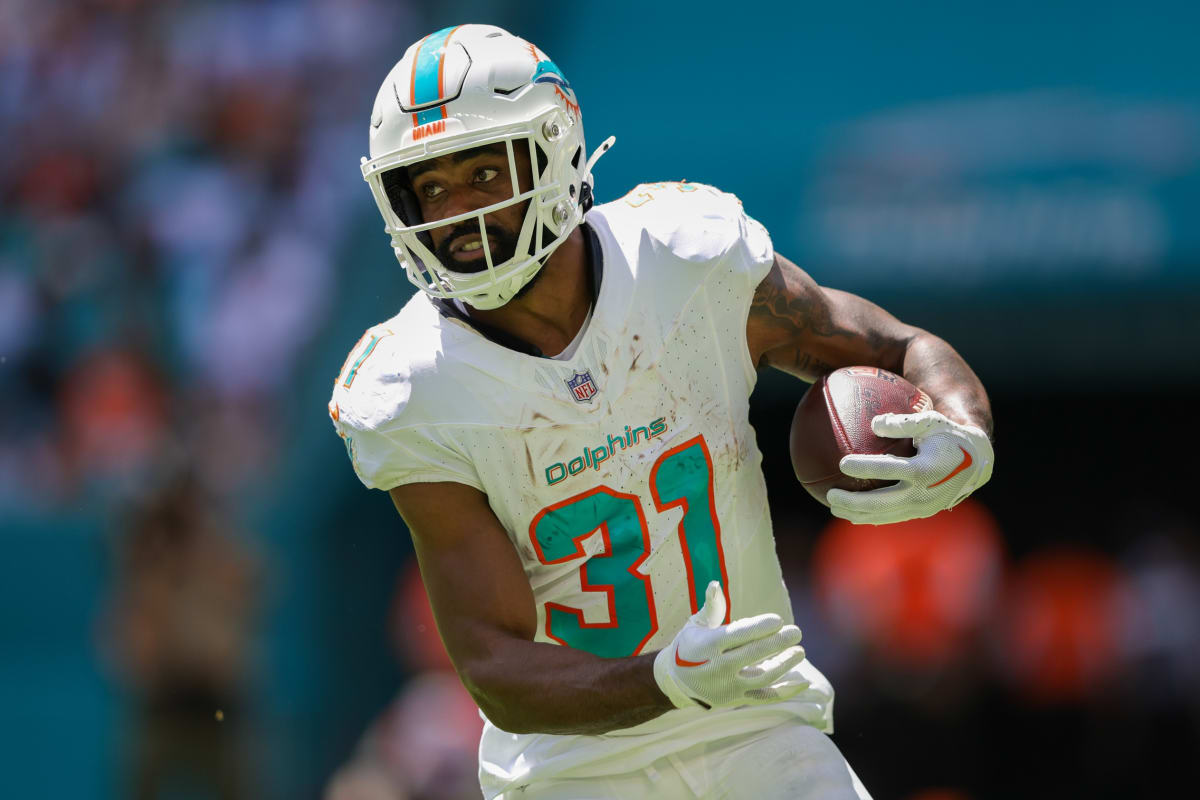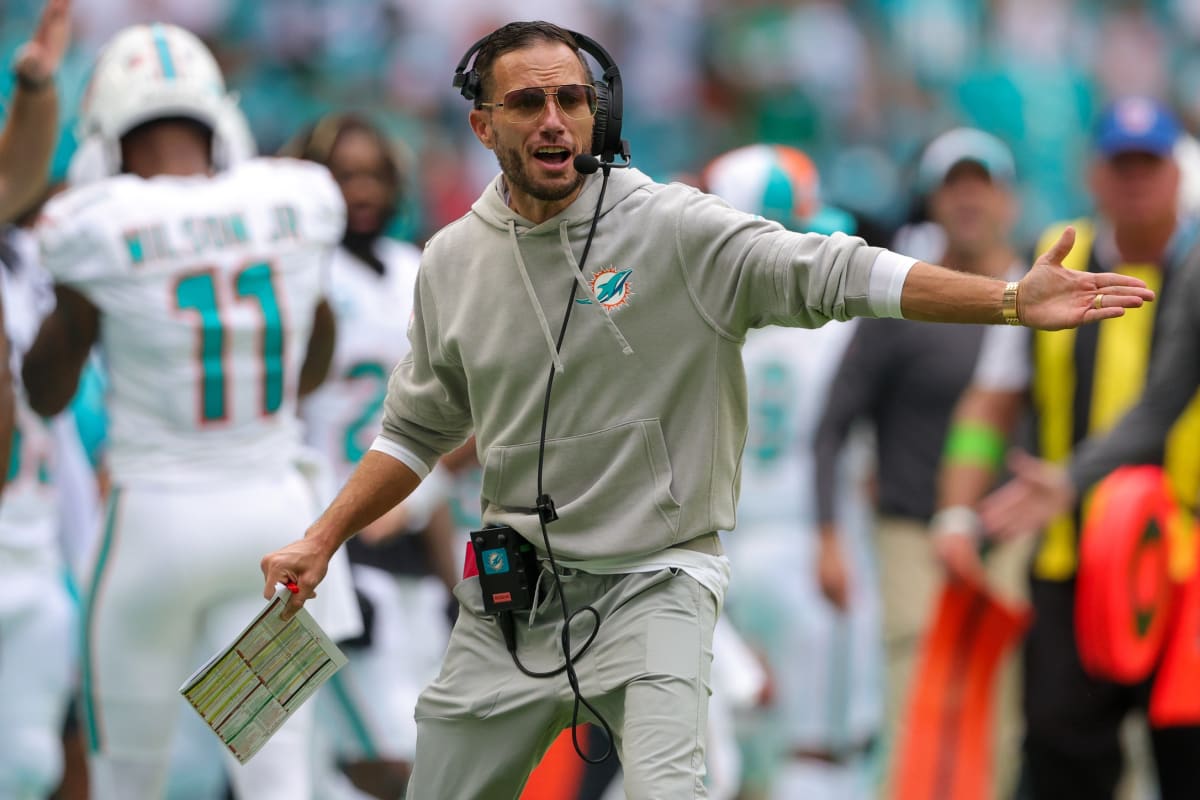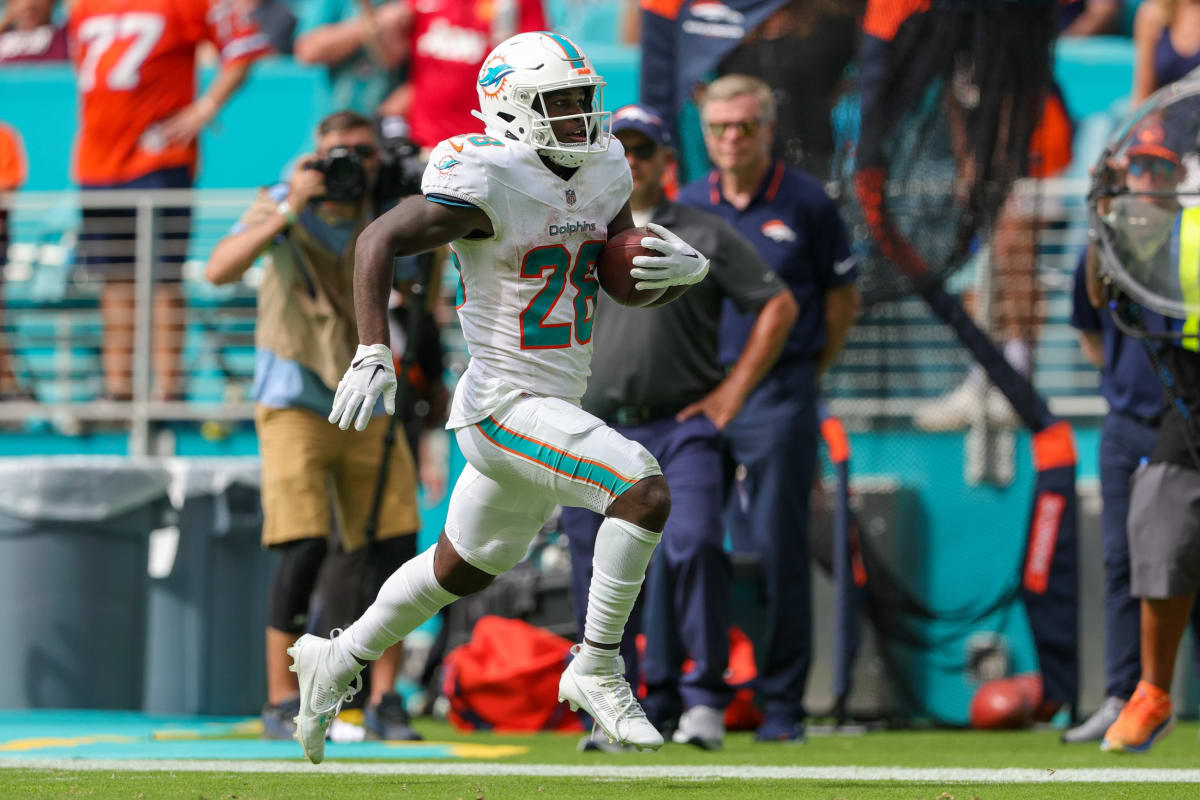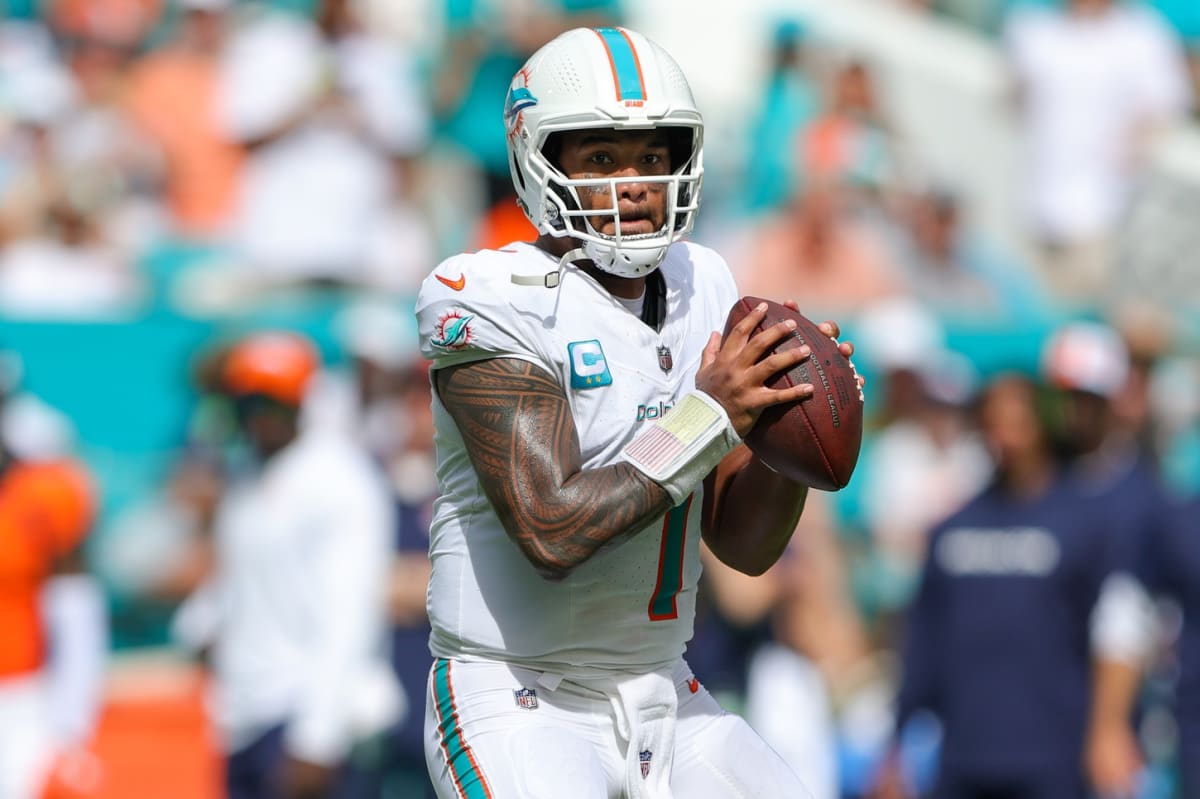More from Albert Breer: NFL Week 3 Takeaways: Dolphins Look Like Super Bowl Contenders | Josh Dobbs and the Cardinals Are Enjoying Every Moment | Chargers Found Their 2023 Identity in Win Over Vikings
Raheem Mostert knew that—after seven years of fighting to stay in the NFL, and with just a month left in his 20s, and coming off a season-ending knee injury in 2021—his free agency in ’22 could be his final bite of the financial apple as a pro football player. So he, like any guy in his situation, was aware of the stakes.
And, of course, money was going to be a factor.
But he also had an idea of whose offense he wanted to play in when his eighth season commenced. And it didn’t take long for Mike McDaniel to affirm the reasons for it. Mostert struck a one-year deal to follow the new Miami coach from San Francisco, choosing the Dolphins over, among other options, returning to the Niners.

Nathan Ray Seebeck/USA TODAY Sports
“We had a long, extensive conversation,” Mostert told me Sunday night, as he was winding down after a wild afternoon at Hard Rock Stadium. “That led to not the signing; it was after the signing. But I truly believed in him, that he would get the job done and we could do great things together. And I knew he was gonna need some help, just implementing this offense and having guys that understand and everything like that. So, yeah.”
So here we are a year and a half later, and the result of that conversation is more than a very optimistic Mostert could’ve possibly imagined.
What’s really wild about what the 31-year-old tailback and his teammates pulled off Sunday is how, coming in, the Dolphins were already first in the NFL in total offense, yards per play, passing offense, yards per pass play, and second in first downs. And, somehow, even with all that already established, this sleepy early kickoff against Sean Payton, Russell Wilson and the Broncos would be the afternoon that would serve as Miami’s breakthrough.
It also served notice to the rest of the league what McDaniel is capable of with the arsenal he and Miami GM Chris Grier have assembled.
When the clock expired, and the Dolphins were done throwing haymakers, the scoreboard read 70–20, and Miami had become the first team since before the first Super Bowl (1966) was played to break the 70-point barrier, had rolled up the second-most yards in a game (726) in NFL history and most since Harry S. Truman was president, and had become the first team to rush for 350 yards and throw for 350 yards in the same game.
McDaniel would be the first to tell you it’s not him. And with Tua Tagovailoa playing like an MVP candidate, Tyreek Hill looking as good as ever, and Jaylen Waddle (who, remarkably, didn’t even play against Denver) developing into a star, he’s right about that. But he’s also getting the most out of those guys, the same way he is with veterans such as Braxton Berrios, River Cracraft and Durham Smythe.
And Mostert, too, just the way the old back knew he would.
The Week 3 MMQB is here, and even coming out of what was a pretty dull Sunday, we’ve got a lot for you this week.
• A look at the journey Cardinals QB Josh Dobbs took to get here.
• Why Brandon Staley still believes in his Chargers.
• Takeaways on a couple of AFC South upstarts, Deshaun Watson and a whole lot more.
But we’re starting with the Dolphins, and the offensive machine McDaniel has built in South Florida.

Nathan Ray Seebeck/USA TODAY Sports
After the Dolphins’ mind-twisting performance earlier in the day, I hit up a bunch of front-office types who’d looked at Miami over the past couple of weeks to try to best explain what’s made McDaniel’s offense so freaking hard to handle this September.
“They have speed at all levels,” says one exec. “And they can stretch the field horizontally and vertically.” Another echoed that, saying, “It looks like they do a heck of a job stretching you both vertically and horizontally with speed and creative play designs.”
A third says, “It’s the head coach’s high football IQ, having an anticipatory quarterback with accuracy, and then vertical and horizontal speed, and run-after-catch ability.” And a GM I texted pointed to the Shanahan pedigree, saying, “I looked last week, and four of the top eight offenses had coaches from that group. Talent, plus that scheme, is tough to stop.”
The GM was right, of course—Miami, San Francisco, Minnesota and the Rams were the teams he referenced. But, really, what I was looking for in trying to figure out how something like Sunday happens was trying to pinpoint what’s separating the Dolphins now.
And, in doing this, a fifth executive gave me the crux of what I was searching for.
“They’re fast, creative and efficient,” he says. “That’s a [stock] response, but it’s all true. They have great personnel, and [McDaniel has] a great mind that is able to look at it, and figure out how to make it work. It’s hard to be dynamic and explosive while being efficient and consistently productive.”
Bingo. The Dolphins are both, and Sunday was the most extreme example of that dynamic.
Consider this: By the time Tagovailoa and the Miami offense were confronted with their first third down of the afternoon against Denver, they’d already scored two touchdowns and were marching toward a third with 12:48 left in the second quarter. And that was third-and-4, which they’d convert despite a holding penalty putting them in first-and-20 two plays earlier.
At the half, Miami had scored five touchdowns, while getting to third down only twice (the other third down was a third-and-1). Their first third down of more than five yards came on a third-and-7—the final play of the third quarter—and they scored on a little swing pass from Tagovailoa to Mostert. That was Miami’s seventh touchdown.
Let’s say that again: On Miami’s first third-and-long of the afternoon, the Dolphins scored their seventh touchdown. It was also Tagovailoa’s only third-and-long of the day.
So while the rest of us gawk at all the big plays Miami’s track team of skill players is scorching the NFL with through three weeks, the Dolphins are also backing it up with a numbing level of efficiency on offense at almost all times. The big plays and efficiency allow McDaniel, armed with all that weaponry, to have a wide-open playbook on just about every snap.
And on Sunday, we saw the results.

Nathan Ray Seebeck/USA TODAY Sports
There’s a reason why Shanahan and McDaniel collected backs and receivers in San Francisco who, quite simply, could outrun everyone. Much of it was founded on a simple belief—the scheme will create seams, and openings, and if there are guys who run 4.3 or 4.4 running through those (it was that element of speed that, for example, prompted the Niners to grow Mostert’s role years ago)—the opponent’s defense is going to be in a lot of trouble.
And Mostert’s four-touchdown day—he had one of those four years ago in the NFC title game, too—was the best illustration of that speed and explosion. So let’s let him tell the story of those scores.
• The first came from 20 yards out, near the end of the second quarter, with a classic Mike Shanahan family call. “It was an inside-zone run, and I just had to make a play,” Mostert says. “The O-line, they did a great job getting me up to the second level. And once they get to the second level, then I look at it as, Hey, I got to move to that third level. So everything else is all me, and I was able to bounce it out and then score a touchdown.”
• The next two veered from that, both coming from the goal line and on downhill, hat-on-hat calls. Mostert called his three-yarder “more of an aggressive play, just get the ball downhill and then score. That’s pretty much what happened.” And he says his one-yarder to follow was “more so one of our power plays, just get the ball downhill as fast as we can and follow the lead block, which is Alec Ingold. And then just find that crease and then hit it.”
• And the fourth score came as a result of not just the growth of the offense but also its quarterback (we’ll have more on him in a bit). “The touchdown catch [was just] a swing pass,” Mostert says. “I was basically last in the progression. And then once Tua didn’t see anything on the right side, he was going to come to me on what was basically a screen play. And then that’s when I had lead blockers and then found a way to get in.”
A lot of teams, of course, have all these things in their offense. What’s different here, with Mostert’s day, is how it shows McDaniel is able to use different guys in a lot of different ways—which helps fuel an offense built on making everything look the same to a defense presnap, to prevent defenders from getting a head start on anything schematically.
“Guys have to be able to master their talents in different phases—blocking, running, even catching the ball out of the backfield,” Mostert says. “To be able to have guys like myself, [Devon] Achane, Salvon [Ahmed], Jeff Wilson, Chris Brooks, I mean Darrynton Evans, who is on the practice squad, for us all to be in that mix of guys that can catch the ball out of the backfield, but also block and run the ball, too, that’s what you kind of need in this offense.”
Which is one positional snapshot of showing that, clearly, McDaniel has what he needs in Miami.

Nathan Ray Seebeck/USA TODAY Sports
A big part of that, of course, is the quarterback, because there’s no way the Dolphins can operate as efficiently, and explosively, as they have without that position producing at a very high level. And Tagovailoa has played lights out in his second year under McDaniel.
That said, his numbers Sunday were over the top. At halftime, he was a perfect 16 of 16 for 206 yards and two touchdowns. His first incompletion came on a shot to Hill with 9:44 left in the third quarter. And, as Mostert explained in going through his touchdown catch, a lot of this now, for Tagovailoa, is his ability to reach deep into his progressions and pull out every answer the offense has for him.
“I mean, it’s not just that play,” Mostert says. “If you actually see, and watch his game, there’s been several instances within these several games where he goes through his progressions and he reads what he has to read and makes the appropriate throws. So, I mean, it’s just a little, minute piece to his game, but he’s definitely grown in that aspect. He’s continuing to get better each week.”
So like the offense as a whole, Tagovailoa’s also making the big play and the right play consistently, which, now, with this version of Miami’s offense, is kind of like keeping a bullet train on the tracks.
And that he’s found a way to do that isn’t by mistake, either.
It’s another tenet, in fact, of how the coaches, and an invested group of players, put together this machine—and one they drilled over and over and over in the offseason.
During the spring, the staff told the players that they’d need to cut out presnap penalties, one area where the team as a whole needed to work through a mostly successful first season for the new Dolphins regime. So the players, as Mostert put it, “took that as a challenge,” and embraced all the mundane drill work it’d take to master the offense.
“We actually took on the challenge of getting lined up properly fast,” he says. “We know that we motion more than anybody in the entire league. So we wanted to utilize [the play clock], and utilize the snap count and everything [to do it].”
The result? In Mostert’s humble words, “So far, we’ve been able to do it.”
Maybe the Dolphins players didn’t see 70 points coming, or a perfect first half against Denver for Tagovailoa, or a breakout, 200-yard performance from the rookie speedster Achane, or not skipping a beat in a game without Waddle. But they did know they were capable of a lot—based on last year—the talent on hand, and the scheme they were in.
And so in working on the little details they’d fumbled around with in 2022, an idea was born. That idea has since grown into an unshakable belief in what the unit is capable of offensively.
“We’ve always thought the only people that can beat us is us,” Mostert says. “If anybody’s gonna beat us, it’s gonna be ourselves. It’s not going to be because they have a better defense or whatever. That’s how we feel and that’s what we’re doing right now.”
It’s definitely what they did Sunday against the Broncos.
Which, truth be told, is even better than what Mostert had in mind 18 months ago.







